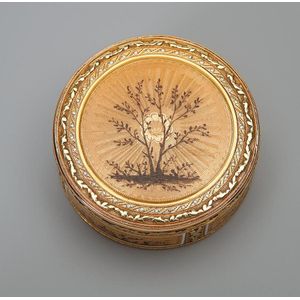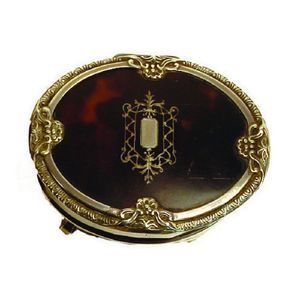Malachite & Gold Brooch with Gemstone Floral Centre
You must be a subscriber, and be logged in to view price and dealer details.
Subscribe Now to view actual auction price for this item
When you subscribe, you have the option of setting the currency in which to display prices to $Au, $US, $NZ or Stg.
- Malachite - Malachite is bright copper-green coloured stone with concentric layers which displays distinct contrasting veinings. It has been valued in the past for making or decorating small precious objects such as clocks, jewellery, dishes and so. In the Orient it was used for snuff bottles and in Russia and was favoured by the Faberge workshop. larger pieces were used for table tops.
The principal source of supply was Russia but it is to be found in other regions such as Southern Africa, Mexico, Australia and France.
Malachite glass is a manufactured material that was intended to resemble malachite, but often bears more resemblance to a veined coloured marble due to its lower gloss finish and lack of concentric layers. Malachite glass was manufactured by many glassworks in the 19th century including Loetz in Austria and others in Bohemia and Davidson's Greener's and Sowerby in north eastern England.
It was particularly used for scent bottles, bowls, and small vases often decorated with nymphs.
Malachite glass has been manufactured continuously since the late nineteenth century, most is unmarked and it is difficult to distinguish the age or manufacturer of most commercial pieces. - Filigree Work - Jewels - Filigree is delicate and intricate ornamental metal-work made from thin threads of gold or silver, soldered and twisted together to give the effect of lace. The filigree work may be freestanding, or attached to the surface of an object.
- Emeralds - Emeralds have been used in jewellery making for thousands of years, and are prized for their deep green colour, which is caused by the presence of chromium and vanadium in the mineral beryl. Because of their rare colour, emeralds are often more valuable than diamonds of a similar size and quality. In jewellery making, emeralds are typically cut into round or oval shapes to maximize their color and clarity. They are often set in gold or platinum and used as the centrepiece of a piece of jewellery, such as a ring or necklace. They can also be used in combination with other gems, such as diamonds, to create intricate and beautiful designs.
This item has been included into following indexes:
-
brooches, diamond
- diamond and emeralds 209
- diamond and ruby 435
- diamond and sapphire 417
- brooches, floral design - floral design, gold mounted 904
-
brooches, gold
- gold with rubies 675
- gold with sapphires 612
-
brooches, set with
- filigree decoration 132
- malachite 37
Visually similar items

Victorian 18ct Grand Tour Petra dura brooch Ins '10 $1,800

An enamelled two colour gold bonbonniere, maker's mark of Les Freres Toussaint, Hanau, circa 1780, of circular form, the lid and base with dendritic motifs to pale-apricot guilloche panels within a fine border of white enamel pellets and a further border o

A George V silver plique-à-jour dressing table box, oval shape, the hinged lid inset with tortoiseshell, inlaid with a fine silver cartouche, raised on four scroll feet. Birmingham 1926. Width 7 cm

An antique cameo brooch, the oval shell cameo finely carved depicting Jesus, Mary and the three wise men, mounted in a gold frame with rope twist detail, total length 590 mm
